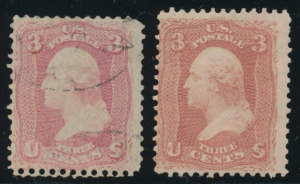There are many types of guarantees in philately and there are many types of opinions. It is important that collectors distinguish between the two and understand what protections each provides. The major expertization services-the APS, the Philatelic Foundation, Professional Stamp Expertizing service, Sergio Sismondo-indeed all of them, offer an opinion, based on current knowledge, of the genuineness and quality of the philatelic item presented to them. This is reassuring to collectors and of value as there are many stamps where the forgeries outnumber the genuine and hidden faults exist on many stamps. But it is important to note that despite the expense involved in having stamps expertized (which is often 5% of the catalog value-with a $25 minimum- and since many stamps are bought at 25% of catalog this can work out to as much as you paid for the stamp itself), it's important to realize that what you are paying for when you expertize a stamp is an opinion only. Traditional certification
Daniel Tourish
- Posted January 04, 2019in NewsRead more »
- Read more »
 One area where the Scott catalog is inconsistent and unreliable concerns shades. Most stamps of the Nineteenth Century exist in numerous shades. The reason is simple. Ink colors were hard to match and when different printings of the same stamps were made, while the printers attempted to match the inks, there was no foolproof way of matching the color exactly from one printing to the next. The Scott catalog on US stamps attempts to list most of the major shades and usually they are listed as minor varieties which is what they are. But sometimes the shades are a bit more startling or glamorous and the early catalog editors made them into entirely different Scott numbers. One of the more egregious examples of this is the Pink variety of the three cent 1861, which was given it's own catalog number (#64) as opposed to the regular red brown shade of #65. The pink is really just an early printing of #65 and it is a hard shade for many collectors to identify. The color is changeable. I have seen
One area where the Scott catalog is inconsistent and unreliable concerns shades. Most stamps of the Nineteenth Century exist in numerous shades. The reason is simple. Ink colors were hard to match and when different printings of the same stamps were made, while the printers attempted to match the inks, there was no foolproof way of matching the color exactly from one printing to the next. The Scott catalog on US stamps attempts to list most of the major shades and usually they are listed as minor varieties which is what they are. But sometimes the shades are a bit more startling or glamorous and the early catalog editors made them into entirely different Scott numbers. One of the more egregious examples of this is the Pink variety of the three cent 1861, which was given it's own catalog number (#64) as opposed to the regular red brown shade of #65. The pink is really just an early printing of #65 and it is a hard shade for many collectors to identify. The color is changeable. I have seen - Posted June 19, 2018in NewsRead more »There are three things that every collector should do to maximize the return that they receive for their stamps when they go to sell, and I will address them in ascending order of importance. First, it is very important to have some figures on your stamp collection. Do you have records of how much you spent? If so, add them up. If not, make a fair estimate based on the amount you felt like you spent per year over the years, making allowance for the years that your collecting was dormant. Most collectors won't get back the full amount that they spent, but at least this will give you some basis to judge how much your collection is worth. If you can catalog the collection by a recent year of the Scott catalog, it is a good idea to do so. Collections generally sell at low percentages of Scott value but they do sell at percentages, and this is a way to evaluate the offers that you receive. Further, it lets you contact dealers in an informed way and enables them to give some idea of their le
